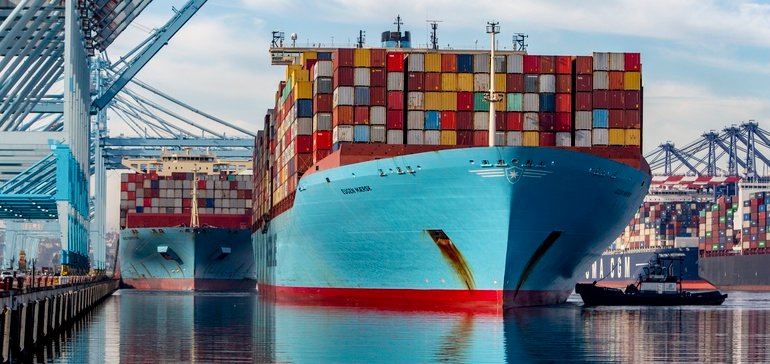The COVID-19 crisis literally had an adverse effect on the global trade with the maritime industry facing the biggest setback in years. Though the industry is trying its best to adjust to the new normal by scaling up digitalisation efforts in business operations and adopting smart strategies to remain functional in this difficult hour, recovery seems questionable anytime before 2021.
Ritika Arora Bhola
The global maritime industry is sailing through turbulent waters since the last few months. The impact of COVID-19 pandemic on the maritime industry has been so hard that sea traders, globally, are not expecting recovery anytime soon that too after a sharp decline in import and export, reduced demand for containers, increased turnaround times at ports, unprecedented fall in crude oil prices, high costs, cargo rollover and blank sailings. However, amidst the pandemic’s deterring effects, the global shipping industry is trying its best to adjust to the new normal by standardising business processes and rolling out other innovative solutions to support the ecosystem.
The need for evolving freight technology and digitalisation has gained momentum since the lockdown was imposed with more and more freight movers agreeing to the importance of having robust IT infrastructure to ensure supply chain resiliency. The pandemic has actually accelerated technological innovation and increased investments into evolving tech platforms in conducting trade, as this is the only way possible for this labour-intensive industry to survive.
Foreword
Steve Felder, Managing Director, Maersk South Asia says, “Globally, in the second quarter of 2020 (April – June), we witnessed a drop in volumes of 16 per cent however it has started rebounding now. In India particularly, the volumes dropped in the second quarter by over 25 per cent as compared to the same period last year. Exports have since bounced back strongly, whilst imports remain subdued. The growth drivers for exports are the increased demand of commodities such as plastic, rubber and vegetables. Garments and apparels are also contributing greatly to the recovery with demand bouncing back after a big slump witnessed during the lockdowns around the world.”
Rajesh Ramchandani, Senior Director- Ocean – Indian subcontinent, DSV agrees that exports are at a high and at pre-pandemic levels with a strong demand and pipeline, but simultaneously accompanied by massive decline in imports which is creating a severe imbalance in equipment.
Consequence of this equipment imbalance, Ramchandani says is crimping ocean exports, sending freight rates up and specifically on 40 dry units. The situation further precipitates with shipping line mandating vessel blankings, slidings, cancellations and capacity network adjustments optimisation. Freight rates would continue to remain inflated, as trade anticipates an upward sloping curve.
The emerging trends, according to Ramchandani, that should influence trade flows as manufacturing shifts out of China would result to near shoring and dual sourcing. “Other key growth drivers that would continue to impact us would be prompt innovation to meet changing needs, digitisation bringing in efficiency and converting the same to gains and cost savings, and finally cash, which for the next couple of years would allow companies to leverage in a bigger way owing to market dynamics and customer behaviour, especially post-pandemic.”
“COVID-19 pandemic disrupted global trade flows at an unprecedented scale,” says Dr Abhijit Singh, Executive Director, Indian Ports Association (IPA). Citing some quick facts, Singh adds, “UNCTAD estimates global merchandise trade to drop by 20 per cent in 2020, and expects a contraction of 27 per cent in the second quarter. As a result, global ship calls have also dropped. As per UNCTAD data, for first half of 2020, global ship calls contracted by 8.7 per cent.”
Despite the drastic fall in demand, Singh says, effective capacity management by liner shipping companies has helped prevent the collapse of freight rates, including container freight rates which have remained relatively strong. “Compared to the 2008-2009 financial crisis, freight rates remained strong as carriers observed a strict capacity management approach.”
“The revision of capacity management plans and changes in shipping schedules are said to be a key feature of the adjustment measures introduced by shipping lines in the face of lower demand. The consolidation that was seen in the industry in the recent past has apparently worked for the carriers this time,” continues Singh.
According to C P Jayakrishnan, Chief Executive Officer, Angré Port, “Due to the coronavirus pandemic, we foresee major changes in the maritime industry in the coming years. The industry will prioritise digital transformation to bring in efficiency and port optimisation. It will now take a focussed approach to digital technology, digital services, and remote operations.”
“The SOPs for manning vessels and equipment will be revisited to ensure the safety and security of the crew. The pandemic cover will gain importance as part of the crew’s health and life insurance. We expect to see a lot more transparency in the costs of operating vessels. This will help everyone in the industry to budget and control the cost,” adds Jayakrishnan.
“The current day scenario sees different challenges in terms of box shortages in certain regions, repositioning issues, ports such as Colombo affected by COVID-19 creating delays, high freight rates, and many more,” says Sanjam Sahi Gupta, Director, Sitara Shipping. “In the short-term, the freight rates are expected to remain healthy, however, in the long-term the rates would depend on the number of factors such as the rate of economic recovery, localisation of supply chains, trade protectionism and barriers, and growth in consumer demand,” points Gupta.
Key focus and priorities
Globally, estimated year-on-year growth of 17.6 per cent is expected for the logistics market at USD 3,215 billion post-COVID-19, and the major focus of this growth will remain on the continued supply of essential products and building supply chain stabilisation initiatives. However, the factors that may hinder the recovery can be an acute shortage of labour, availability of COVID-19 vaccine, and ensuring that the available workforce adheres to safety protocols amidst a global pandemic.
Gita Gopinath, Chief Economists, International Monetary Fund had said recently, “The recession this year will likely be more severe, and recovery in 2021 will be slower than we anticipated.” Focussing particularly on the maritime sector, she stated that, “The maritime industry will be severely impacted. Although, most of the countries are in recovery mode with international border restrictions being eased, the chances of normalcy being restored in early 2021 are quite unlikely.”
Ramchandani agrees, as he says, “Going by the post-pandemic developments, the uncertainty in the container business is there for certain and which obviously suggests that we may not necessarily face smooth supply chain operations in the near future. As economies change at the global platform, there would be re-allocation of resources, capacity and that would necessitate innovation and agility as key factors for logistics services providers to align to that demand. It would mean alternate supply chain options and expenses to sustain the same.”
Maritime players feel increased investments in digitisation and technology will give an added impetus towards building more robust and agile supply chains which can help achieve recovery.
Advanced technologies like robotics and automation, artificial intelligence, machine learning, data science, Blockchain, etc. will dominate the path to recovery.
According to maritime experts, while the bullwhip effect is going to govern the post-pandemic era of normalcy, businesses will have to resort to a collaborative approach towards the supply chain where visibility-data integration and standardisation will play an important role.
Also, with advanced ‘Track and Trace’ applications, transparency can be induced into the system. With consolidated real-time shipment data available on a single platform that generates predictive analytical insights, a more resilient supply chain can be expected and delivered.
“Digitisation is only a part of the environment. Embedding digital and analytics would enable carriers to receive market projections and alter course which seems to be done under short cycles for now,” says Ramchandani. “An important facet of the supply chain is rooted to how different economies would perform in the post-pandemic situation.”
Ramchandani says, at present the key priorities and focus should be on the following:
- Developing multiple sourcing regions or markets
- Reviving predictability
- Developing a flexible ecosystem of suppliers and partners
- Building collaborative tools and platforms for information exchange
- Strategic inventory positioning
- Increasing revenues but maintaining a broad vision
- Applying additional cost-saving initiatives
- Facilitating business operations through digitisation and bringing in costs reductions
- Focussing on employees
- Focussing on an approach which is more outcome driven
Felder says the three aspects that have emerged as the focal points for every organisation out of the COVID-19 pandemic are– resilience, digitalisation, and empathy.
“Firstly, the organisations and their leaderships that have shown resilience in operations are the ones that have managed to steer away from major disruptions. They are also the ones who have grown and progressed during these tough times. To make resilience a part of your daily operations and agility a part of your behaviour has become essential.”
“While many stakeholders have adapted the way of digitalisation in one way or another, the remaining must understand that unless the whole ecosystem makes a shift towards digitalisation, it is not going to yield the best outcomes. We must understand that digitalising has not helped avoid a lot of physical contact during this period but also improved efficiency by eliminating time-consuming paper-based processes, which in turn made proceedings error-free.”
“Lastly, every organisation and individual should accept that importance is in empathy. The pandemic has taught us that almost every individual around the world was susceptible to the disease, and that good leaders understood the pains or fears that the people had in their minds during this period. Allowing employees to work from home and not mandating them to come to work, believing in their efforts and appreciating their results will create a long lasting effect. Empathy goes beyond your own organisations’ employees. It has made us, especially in the supply chain sector, go the extra mile to keep the cargo moving as it could be a life-saving effort for many around the world.”
Singh do believes one positive thing that has come out of this pandemic is how the supply chains have speeded-up the digitisation process and moving towards a more integrated and connected network.
“This has also become the key priority of all maritime stakeholders,” he says. Traditionally, digitisation was only viewed from the efficiency and cost control perspective, but now focus has shifted towards resilience as new digital solutions enable stakeholders to mitigate the supply chain risk more quickly and with more confidence.
In this endeavour, IPA has been working on various digitisation efforts among which developing a world class Port Community System (PCS) is foremost. A new version PCS1x, is live and functional since 11 December 2018 and serves as single platform for exchange of data and documents between shipping agents/shipping lines and sea ports.
PCS 1x as an open platform, can be molded and adapted to the industry needs to cater to the National Logistics Portal for all the stakeholders as envisaged. With these features and functional, PCS 1x is evolving further to a world class National Logistics Portal (NLP)-Marine.
“Definitely! The key priority at present is implementation of new technologies. Apart from this, there’s urgent need to up skill and upgrade,” says Gupta. “Managing data is also crucial. These strategies help operators to strengthen relationships with customers, reduce cost and pursue new revenue streams beyond the traditional services.”
“Digital platform- NLP-Marine is envisaged as the central hub in all interactions with various stakeholders, viz. port, terminals, shipping lines/agents, CFS, customs brokers, importers/ exporters. These interactions are expected to take place in real-time. The communication among the stakeholders should be fast, reliable, recordable and device independent. Furthermore, the value-added system should be able to provide audit trail of all processed transactions.
Path to recovery
At this point of time, experts feel it’s not possible to make long-term forecasts for the maritime sector given the uncertainty of the global trade at present. However, what is certain is the fact that the path to recovery can be identified in the beginning or middle of 2021. According to reports, container volumes are most unlikely to return to a normal level anytime before 2021. The crisis has accelerated the decline in the growth of demand for container shipping which reflected in how shipping lines have effectively removed capacity to manage otherwise over-tonnage scenarios.
As per recent data, as to what Jayakrishnan says, a gradual recovery can be spotted in global trade. It shows that the global container ship arrivals dipped below 2019 levels in mid-March 2020 but started picking up around the third week of June. Post-monsoons, in the month of August, September, and October, India too has witnessed similar movement and trade upswing. Shipping timetables have become busier and freight has been improving on various legs, almost reaching pre-pandemic levels on some routes and commodities.
With the global economy expected to contract by 4.4 per cent this year as predicted by IMF there are many uncertainties ahead that are related not only to COVID-19, but also in the economic and political scenario which but naturally impact the maritime industry. “Hence, one would have to be cautious in predicting and most things boil down to short term planning for now which is things to remain the same until Q2 of 2021,” says Ramchandani.
“Although, the capability of the maritime industry to get adapted has improved, it will still struggle for at least the half of 2021 to cope with new market demands as there are many aspects which are hitting our industry for the first time, i.e. container shortage and container index being tracked in various markets along with the ever-changing vessel capacity which carriers have been struggling with due to blank sailings, cessation of service routes, etc.” explains Ramchandani.
The new mantra for liners, he says, has been on-box utilisation and asset deployment, both strong fundamentals which have come to the fore through this pandemic and triggering constant change which is expected to continue in 2021.
“The industry is evidently and firmly on the path to recovery and is getting trained to manage cargo capacity and handling, which encourages me to hazard a guess that it would be somewhere in 2022 which should allow us to see pre-COVID levels. Supply chains are showcasing singular resourcefulness and adaptability, though the challenges are far from over. The preferred outcomes may be fundamental changes and a host of managers and regulators that find it second-nature to rethink global models and supply dependencies. From my point of view, the appetite for growth is there but on a more controlled manner. Additionally, the consolidation of carriers and freight forwarders would continue to bring more stability to the industry,” says Ramchandani.
If we analyse the data of cargo handled at India’s Major ports, the worst effect of pandemic was seen in the month of May’2020 when total cargo handled dropped by -23.25 per cent vis-à-vis the same period last year.
Singh says traffic data started showing recovery signs since June’2020 and by September’2020, the traffic handled at Major Ports showed huge recovery with just -1.93 per cent drop vis-à-vis last year in total traffic and container traffic growth turned positive with 6.17 per cent growth in tonnage and 1.88 per cent growth in TEUs. “With economy further opening and demand rising, we expect cargo handled growth performance to be even better.”
“Outlook for near term looks very robust and positive for maritime industry and as already mentioned in the case of ocean freight rates, long term performance would depend on the number of factors such as the rate of economic recovery, localisation of supply chains, trade protectionism and barriers, growth in consumer demand and other global factors,” he informs.
“I feel the maritime industry has gained more importance during the COVID-19 pandemic,” says Felder. “This is the industry that kept supply chains moving in a cost-effective manner. This is the industry that provided for support to societies in terms of health, food, pharmaceuticals and other crisis-essential goods. We already know that shipping is the most cost-effective solution for moving goods around the world and it will continue to be,” asserts Felder.
“We can see that the cargo volumes are improving and recovering. They will continue to grow closer and closer towards the pre-COVID times over the next few months. However, it is unclear what 2021 and beyond will look like. The total volume is recovering but there is still some time before we get to the pre-COVID levels. There are new trends emerging due to the COVID-19 pandemic and some of these include changing sourcing patterns as well as changing retail behaviours. Cargo volumes might go up, but their origins and destinations might vary in the coming years. E-commerce is an area that will continue to grow and gain more importance in the future.”
“This is the time of change, this is the time to see who can adapt to the changing needs,” says Gupta. “The shipping industry is going to change completely in terms of its players. It’s possible the traditional players will no longer exist tomorrow. The strongest threads today are from the players adopting digital technology as a basis for an asset less business model that lets them compete with the lower cost base.”







